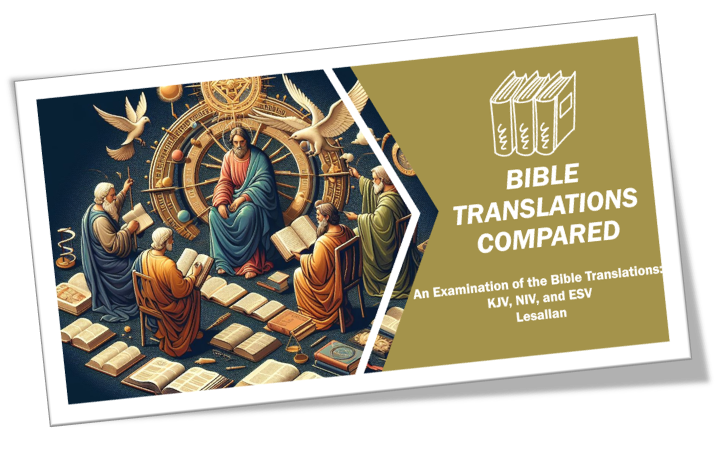Written by Lesallan – April 10, 2024

An Examination of the Bible Translations: KJV, NIV, and ESV
The Bible, which was originally written in Hebrew, Aramaic, and Greek, has been translated into countless languages throughout history. This post delves into three notable English translations: the King James Version (KJV), the New International Version (NIV), and the English Standard Version (ESV). These translations were selected due to their widespread use and distinct translation approaches.
The King James Version, initially printed in 1611, is a formal equivalence translation that aims to replicate the exact language of the source material (1769 King James Bible Introduction KJV, 1769). Its primary audience is comprised of faithful individuals, and it is based primarily on earlier versions of the Greek text put together by Erasmus, who relied on some manuscripts from a later period (1769 King James Bible Introduction KJV, 1769).
First introduced in 1978, the NIV translation philosophy is based on dynamic equivalency, or thought-for-thought, to ensure both accuracy to the source material and readability in modern language. This version is perfect for personal devotion and group Bible study, as it draws upon the most dependable and up-to-date manuscripts of the original texts (New International Version, 2019).
The ESV, initially released in 2001, is a translation that strives to maintain the exact language and style of the original text. It is a perfect choice for those who desire to study the Bible in-depth, whether for public reading, preaching, private reflection, academic research, or devotional study. The ESV’s goal is to remain as faithful as possible to the original Hebrew and Greek texts (Logan, 2019).
As Plummer’s (2018) analysis shows, the KJV has faced significant scrutiny in its time from those who favored preceding translations, leading to multiple revisions. Nonetheless, it remains highly regarded as one of the most faithful renditions of the Bible. Its virtues are rooted in its precision of language and contextual relevance. However, its employment of antiquated terminology may pose a challenge for contemporary readers.
If someone in your church asks for guidance on which Bible translation to read, a thoughtful and inclusive response could be: “The answer depends on what you hope to gain from your Bible reading experience. If you value a translation that closely adheres to the original text, the ESV may be a good fit. If you prefer a balance between accuracy and ease of reading, the NIV could be a viable option. For those who appreciate a more traditional and formal language style, the KJV may be a preferred choice. Additionally, incorporating multiple translations can enhance your understanding of Scripture.”
In conclusion, the King James Version (KJV), the New International Version (NIV), and the English Standard Version (ESV) each have distinct strengths and cater to diverse audiences. Understanding their translation philosophies, targeted readerships, and foundational texts can assist readers in selecting the translation that best meets their requirements.
Blessings,
Lesallan
References:
1769 KING JAMES BIBLE INTRODUCTION KJV. (1769). Www.kingjamesbibleonline.org. https://www.kingjamesbibleonline.org/1769-King-James-Bible-Introduction/
Logan, C. (2019). English Standard Version – Read Online. Bible Study Tools. https://www.biblestudytools.com/esv/
New International Version. (2019). New international version Bible – read free online. Bible Study Tools. https://www.biblestudytools.com/niv/
Plummer, R. (2018). Is the King James Version of the Bible the most accurate translation?
[Video]. YouTube. https://www.youtube.com/watch?v=FjfvtvmgT3s


